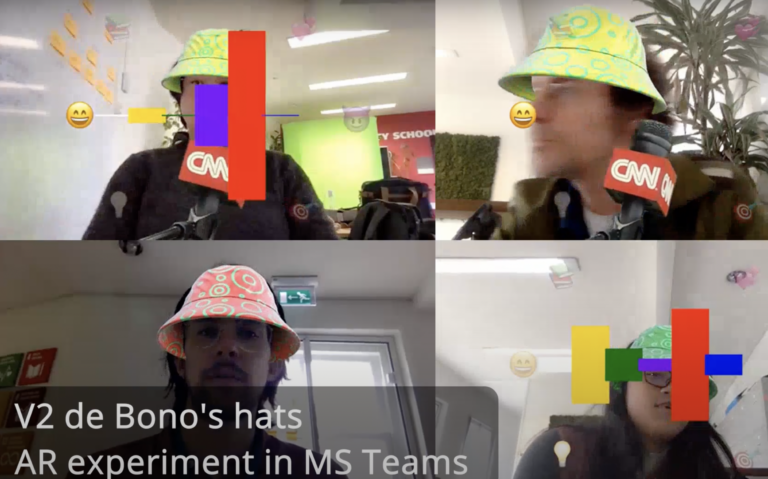Using our reflections on the way social interactions were changed through video meetings, we thought of a method that is applied in classrooms to stimulate group interaction called: Bono’s Six Thinking Hats. This method requires participants to put on a hat that represents six different dimensions of thinking or attitudes from which someone can be approaching a meeting; emotionally relating, managerially controlling, positively reinforcing, negatively critiquing, creatively associating or analytically observing. Wearing a specific hat makes both the wearer conscious of their attitude as well as making that explicit to other participants. Our hypothesis was that wearing hats can relieve some of the strenuous focus that video meetings create by helping the wearer to communicate to others more visually and implicitly aspects around their current state of mind. At the same time, wearing different hats could break the monotony of meetings, perhaps making them more enjoyable, while having a purpose. Continuing from the reflection on the challenge for teachers to include all students in a class, we hypothesized that it could be useful to get real-time feedback on how much a student has been participating in a video meeting. This is where the possibilities of the digital medium can add something beyond what physical hats in a classroom could; time wearing a digital hat is more easily quantified.
After creating the hats filter we instructed a project team at AUAS to use the filter during a one hour meeting. In this meeting the team was discussing a design and how to choose from different concepts. We explained the use of the hats briefly before starting the meeting; Bono’s method as well as how to change hats and see the statistics; how long any hat has been worn. In this experiment we had participants originating from Brazil, Italy, Czech Republic, Russia and the Netherlands aged between 21 and 35.
It surprised us that the hats were also being used while people were not talking, more akin to the way that emoticons or reactions can be used in meetings to visually signal for example their appreciation. We could say that Bono’s method has not been applied how it was originally intended. However, there was still a positive effect to be observed which we concluded when we interviewed the participants. One participant mentioned that the meeting became a lot more fun while remaining productive. Another participant mentioned that it was nice to be able to be more clear about their emotions or intentions with the hats.
Short biography
Why wait until the tech that shapes our future is a given? Instead, let’s work on ideas to successfully integrate digital technology in our lives and society today. At Digital Society School we invite you to direct your interests, knowledge and effort towards building a digital society. Because we believe that it can -and should- be inclusive, intelligent, and involve us all.
Change is paradoxical, in that we continuously strive for it while being afraid of it at the same time. Transformation takes this one step further. It touches the core of what everything has been like up to the point of transformation. It requires creativity and courage: the courage to pursue grand, abstract goals and the creativity to solve, by 2030, the challenges the world now faces.
To this end, we have founded the Digital Society School. Through the school, we seek to research the impact of technology on society, develop the skills necessary to guide the transformation and pass on this knowledge and these skills to a new generation of professionals. They are ready to begin work on the United Nations Sustainable Development Goals for 2030. They will be the architects of transformation, across the world as well as in your organisation
